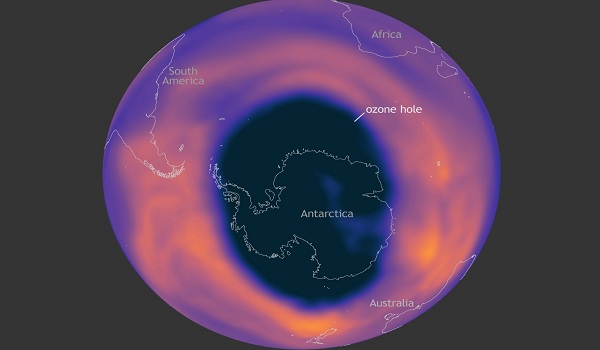Contrary to public perception, the Antarctic ozone hole has been the largest on record over the past three years, new research has found.In their study published in the journal Nature Communications, the researchers said that the ozone hole over Antarctica has become significantly larger and longer lasting over the past four years and that chlorofluorocarbons are not solely responsible for it.
Key Highlights of the Study
Ozone Depletion
- The Antarctic ozone hole has been consistently large and has shown thinning over recent years, contrary to the expected recovery trend observed since the 2000s.
- The concentration of ozone at the center of the hole has notably reduced, indicating significant thinning of the ozone layer.
- The concentration of ozone at the core of the ozone hole has decreased by 26% from 2004 to 2022, despite the efforts outlined in the Montreal Protocol, which aimed to reduce human-generated chemicals that deplete the ozone layer.
Polar Vortex Influence
- The Antarctic ozone hole exists within the polar vortex, a circular wind pattern in the stratosphere that forms during winter and is maintained until late spring.
- Within this vortex, the Antarctic air from the mesosphere (the atmospheric layer above the stratosphere) falls into the stratosphere. This intrusion of air brings natural chemicals (nitrogen dioxide, for example) which impact ozone chemistry in October.
Factors Affecting Ozone Depletion
- The role of meteorological conditions, such as temperature, wind patterns, aerosols from wildfires and volcanic eruptions, and changes in the solar cycle, influenced the size and behavior of the Antarctic ozone hole.
Recommendations
- There’s a need for further research to understand the descent of air from the mesosphere and its specific impacts on ozone chemistry.
- Investigating these mechanisms will likely shed light on the future behavior of the Antarctic ozone hole.
Ozone Hole
- An Ozone Hole refers to a severe depletion of the ozone layer—a region in the Earth’s stratosphere containing a higher concentration of ozone molecules.
- Ozone molecules (O3) in this layer play a crucial role in shielding the Earth from harmful Ultraviolet (UV) radiation from the sun.
- The ozone layer depletion leads to the formation of an area with significantly reduced ozone concentrations, often observed over Antarctica.
- This phenomenon occurs primarily during the Southern Hemisphere’s spring months (August to October), though it can also be influenced by global factors.
Reasons for Ozone Hole
- The depletion is caused by human-generated chemicals known as ozone-depleting substances (ODS), including Chlorofluorocarbons (CFCs), halons, carbon tetrachloride, and methyl chloroform.
- These substances, once released into the atmosphere, rise to the stratosphere, where they break down due to the sun’s ultraviolet radiation, releasing chlorine and bromine atoms that destroy ozone molecules.
- The Antarctic ozone hole is the most famous and severe example of this phenomenon. It’s characterized by a drastic reduction in ozone levels, allowing increased amounts of harmful UV radiation to reach the Earth’s surface.
Impact
- The increased UV radiation poses health risks to humans, including higher rates of skin cancers, cataracts, and compromised immune systems.
- UV radiation can harm various organisms and ecosystems. Ozone depletion can indirectly influence climate change. Changes in the stratosphere due to ozone depletion can impact atmospheric circulation patterns, potentially affecting weather and climate in certain regions.

